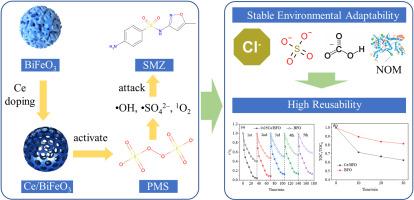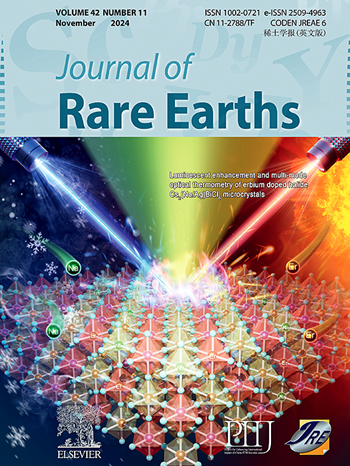Synthesis of Ce/BiFeO3 composites and activation of persulfate for pharmaceutical wastewater degradation
IF 7.2
1区 化学
Q1 CHEMISTRY, APPLIED
引用次数: 0
Abstract
Sulfamethoxazole (SMZ) is a prevalent and recalcitrant micropollutant in water, posing a significant threat to both aquatic organisms and human health. Therefore, investigating the removal of SMZ is of critical importance. In order to investigate the effect of rare earth metal doping on the performance of activated persulfate oxidative degradation of SMZ, BiFeO3 with different Ce doping amounts was successfully prepared by a hydrothermal method. Then, it was characterized by X-ray diffraction (XRD), scanning electron microscopy (SEM), scanning transmission electron microscopy (STEM) and Brunauer–Emmett–Teller (BET) method. The performance of porous Ce/BiFeO3 in the catalytic activation of persulfate (PMS) for the degradation of SMZ in water was investigated using SMZ solution as a simulated wastewater. The impact of Ce doping rate, catalyst dosage, temperature variations, common anions, natural organic matter, and PMS concentration on SMZ removal was systematically evaluated. The characterization results show that the octahedral rhombic structure of Ce can be observed on the surface of this doped catalyst, and Ce doping does not change the crystalline shape of Ce/BiFeO3. The specific surface area of the doped catalyst increases, accompanied by an enlargement of pore size, thereby enhancing the catalyst's adsorption capacity and resistance to contamination by SMZ. Under the optimal conditions of 25 °C, SMZ concentration of 20 mg/L, 0.8 g/L PMS and 0.3 g/L 0.05Ce/BiFeO3 catalyst, the removal rate of SMZ reaches approximately 95% within 35 min of reaction time. Even after five cycles of reuse, the degradation rate of SMZ remains above 88%, demonstrating the catalyst's good stability and reusability. Bursting experiments show that SO4·–, ·OH, 1O2 and O2·– are involved in the catalytic degradation process, with 1O2 playing a dominant role.

Ce/BiFeO3复合材料的合成及过硫酸盐活化降解制药废水
磺胺甲恶唑(SMZ)是水体中普遍存在的顽固性微污染物,对水生生物和人类健康都构成重大威胁。因此,研究SMZ的去除是至关重要的。为了研究稀土金属掺杂对活化过硫酸盐氧化降解SMZ性能的影响,采用水热法制备了不同Ce掺杂量的BiFeO3。然后用x射线衍射(XRD)、扫描电镜(SEM)、扫描透射电镜(STEM)和brunauer - emmet - teller (BET)法对其进行表征。以SMZ溶液为模拟废水,研究了多孔Ce/BiFeO3在过硫酸盐(PMS)催化活化降解水中SMZ的性能。系统评价了Ce掺杂率、催化剂用量、温度变化、常见阴离子、天然有机物和PMS浓度对SMZ去除率的影响。表征结果表明,在该掺杂催化剂表面可以观察到Ce的八面体菱形结构,且Ce掺杂并未改变Ce/BiFeO3的晶形。掺杂后催化剂的比表面积增大,孔径增大,从而增强了催化剂的吸附能力和抗SMZ污染能力。在25℃、SMZ浓度为20 mg/L、PMS浓度为0.8 g/L、0.05Ce/BiFeO3催化剂浓度为0.3 g/L的条件下,35 min内SMZ的去除率可达95%左右。即使经过5次循环使用,SMZ的降解率仍保持在88%以上,表明该催化剂具有良好的稳定性和可重复使用性。爆破实验表明,SO4·-、·OH、1O2和O2·-参与了催化降解过程,其中1O2起主导作用。
本文章由计算机程序翻译,如有差异,请以英文原文为准。
求助全文
约1分钟内获得全文
求助全文
来源期刊

Journal of Rare Earths
化学-应用化学
CiteScore
8.70
自引率
14.30%
发文量
374
审稿时长
1.7 months
期刊介绍:
The Journal of Rare Earths reports studies on the 17 rare earth elements. It is a unique English-language learned journal that publishes works on various aspects of basic theory and applied science in the field of rare earths (RE). The journal accepts original high-quality original research papers and review articles with inventive content, and complete experimental data. It represents high academic standards and new progress in the RE field. Due to the advantage of abundant RE resources of China, the research on RE develops very actively, and papers on the latest progress in this field emerge every year. It is not only an important resource in which technicians publish and obtain their latest research results on RE, but also an important way of reflecting the updated progress in RE research field.
The Journal of Rare Earths covers all research and application of RE rare earths including spectroscopy, luminescence and phosphors, rare earth catalysis, magnetism and magnetic materials, advanced rare earth materials, RE chemistry & hydrometallurgy, RE metallography & pyrometallurgy, RE new materials, RE solid state physics & solid state chemistry, rare earth applications, RE analysis & test, RE geology & ore dressing, etc.
 求助内容:
求助内容: 应助结果提醒方式:
应助结果提醒方式:


